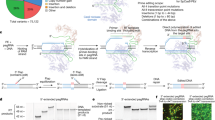Abstract
We report the first identified mutation in the gene encoding human cytochrome c (CYCS). Glycine 41, invariant throughout eukaryotes, is substituted by serine in a family with autosomal dominant thrombocytopenia caused by dysregulated platelet formation. The mutation yields a cytochrome c variant with enhanced apoptotic activity in vitro. Notably, the family has no other phenotypic indication of abnormal apoptosis, implying that cytochrome c activity is not a critical regulator of most physiological apoptosis.
This is a preview of subscription content, access via your institution
Access options
Subscribe to this journal
Receive 12 print issues and online access
$209.00 per year
only $17.42 per issue
Buy this article
- Purchase on Springer Link
- Instant access to full article PDF
Prices may be subject to local taxes which are calculated during checkout


Similar content being viewed by others
References
Jiang, X. & Wang, X. Annu. Rev. Biochem. 73, 87–106 (2004).
Hao, Z. et al. Cell 121, 579–591 (2005).
Ekert, P.G. & Vaux, D.L. Curr. Opin. Cell Biol. 17, 626–630 (2005).
Banci, L., Bertini, I., Rosato, A. & Varani, G. J. Biol. Inorg. Chem. 4, 824–837 (1999).
De Botton, S. et al. Blood 100, 1310–1317 (2002).
Mason, K.D. et al. Cell 128, 1173–1186 (2007).
Briggs, C., Kunka, S., Hart, D., Oguni, S. & Machin, S.J. Br. J. Haematol. 126, 93–99 (2004).
Sabri, S. et al. Blood 108, 134–140 (2006).
Cramer, E.M. et al. Blood 89, 2336–2346 (1997).
Cammack, R. Redox states and potentials. in Bioenergetics: A Practical Approach (eds. Brown, G.C. & Cooper, C.E.) 85–105 (IRL Press, Oxford, 1995).
Finsterer, J. Eur. J. Neurol. 11, 163–186 (2004).
Olteanu, A. et al. Biochem. Biophys. Res. Commun. 312, 733–740 (2003).
Yu, T., Wang, X., Purring-Koch, C., Wei, Y. & McLendon, G.L. J. Biol. Chem. 276, 13034–13038 (2001).
Sharonov, G.V. et al. Apoptosis 10, 797–808 (2005).
Junt, T. et al. Science 317, 1767–1770 (2007).
Acknowledgements
We acknowledge funding support from Lottery Health Research, the University of Otago, the HS & JC Anderson Charitable Trusts and from the Health Research Council of New Zealand. We thank C. Porteous, T. Kleffmann, V. Jalbert and A. Yacia for expert technical assistance, M. Murphy, M. Hampton and A. Reeve for discussions, C. Beresford for clinical assessment, G. Pielak for the cytochrome c plasmid and the affected family for their extraordinary contribution.
Author information
Authors and Affiliations
Contributions
I.M.M. and E.J.C. initiated the study, recruited and evaluated participants; A.J.H., M.W.L., F.M.d.S.T., M.S.A.C. and N.A.B. performed linkage studies, haplotype refinement and sequencing; M.P.S., E.M.C., S.F. and C.C. performed functional platelet and megakaryocyte studies and electron microscopy; P.L.C., R.J.W., E.C.L., A.L., S.M.K.D., G.H., S.M.W., R.D.F. and D.A.P. expressed the proteins and performed functional and structural studies; and I.M.M., E.C.L., E.M.C. and S.M.W. wrote the paper.
Corresponding author
Ethics declarations
Competing interests
A.J.H. was a full-time employee of Pacific Edge Biotechnology Ltd., which owns the intellectual property associated with G41S cytochrome c, when performing experiments and contributing to this paper.
Supplementary information
Supplementary Text and Figures
Supplementary Methods, Supplementary Figures 1–4, Supplementary Tables 1 and 2 (PDF 2718 kb)
Rights and permissions
About this article
Cite this article
Morison, I., Cramer Bordé, E., Cheesman, E. et al. A mutation of human cytochrome c enhances the intrinsic apoptotic pathway but causes only thrombocytopenia. Nat Genet 40, 387–389 (2008). https://doi.org/10.1038/ng.103
Received:
Accepted:
Published:
Issue Date:
DOI: https://doi.org/10.1038/ng.103
This article is cited by
-
Ablation of Cytochrome c in Adult Forebrain Neurons Impairs Oxidative Phosphorylation Without Detectable Apoptosis
Molecular Neurobiology (2019)
-
X-ray structure of bovine heart cytochrome c at high ionic strength
BioMetals (2018)
-
In vitro properties of concentrated canine platelets stored in two additive solutions: a comparative study
BMC Veterinary Research (2017)
-
Non-apoptotic functions of caspases in myeloid cell differentiation
Cell Death & Differentiation (2017)
-
The presence of anaemia negatively influences survival in patients with POLG disease
Journal of Inherited Metabolic Disease (2017)



